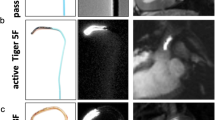Summary
The flow sensitivity inherent to the MR experiment allows for the non-invasive assessment of both the arterial and venous vasculature in any desired plane with good spatial resolution. Data can be acquired in a three-dimensional form, permitting reformating in any plane. In addition, MRI is capable of providing quantitative blood flow information with the use of phase-contrast flow-mapping techniques. Ultrafast gradient echo and echoplanar data acquisition strategies even permit imaging in near-real time. The availability of open MRI configurations now permits one to take advantage of the unique imaging features inherent to MR imaging for the purpose of guidance and control of various intravascular procedures. With the recent development of the MR tracking and MR profiling techniques, permitting visualization of guide-wires and catheters relative to their surroundings in the MR environment in real time, one of the last obstacles to 'Interventional MR angiography' has in effect been overcome. In addition, MR catheters can be modified to acquire high-resolution MR images of the vascular wall, thereby opening vast possibilities regarding characterization of atherosclerotic plaques. This review introduces the underlying techniques for catheter and guide-wire visualization in the MR environment, describes preliminary interventions in animals and humans and discusses the potential of intravascular MRI.
Zusammenfassung
Obgleich die klinische Umsetzung des Konzeptes der Interventionellen MR-Angiographie noch in weiter Zukunft liegt, sind in den letzten Jahren die technischen Voraussetzungen für die Evaluation eines solchen Konzeptes geschaffen worden. So ermöglichen offene Gerätekonfigurationen einen zunehmend freien Zugang des Untersuchers zum Patienten. Hochleistungsgradientensysteme erlauben die Akquisition von komplexen dreidimensionalen Datensätzen, mit deren Hilfe das arterielle wie auch das venöse Gefäßsystem umfassend dargestellt werden kann. Mit der Entwicklung der MR-Tracking- und MR-Profiling-Methoden stehen nunmehr auch Techniken zur Verfügung, mit deren Hilfe intravaskulär geführte Katheter und Führungsdrähte beinahe in Echtzeit sichtbar gemacht werden können. Diese Übersichtsarbeit beschreibt die technischen Voraussetzungen zur Sichtbarmachung von Kathetern und Führungsdrähten in der MRT-Umgebung und beschreibt die Durchführung erster MRT-gesteuerter Interventionen am Tier sowie am Menschen. Darüber hinaus wird das Potential der intravaskulären Bildgebung zur Charakterisierung arteriosklerotischer Plaquestrukturen beleuchtet.
Similar content being viewed by others
Author information
Authors and Affiliations
Rights and permissions
About this article
Cite this article
Wildermuth, S., Zimmermann, G. & Debatin, J. Vascular applications of interventional MRI. Radiologe 38, 210–217 (1998). https://doi.org/10.1007/s001170050344
Issue Date:
DOI: https://doi.org/10.1007/s001170050344




